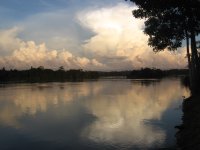Xingu River Journey
Xingu River Sunset (Aviva Imhof) 
It was thus with great excitement and a fair share of sadness that I made my first trip to the Amazon a couple of weeks ago. Excitement to see the river and rainforest that I had dreamed about for so long. But sadness to be going without Glenn Switkes, our Amazon Program Director, who died suddenly last December. I always knew I would travel to the Amazon for International Rivers, but I had always expected to be traveling with Glenn, not in his place. For me, this was a bittersweet journey.
And so it was that I embarked upon the last leg of my 30-hour journey from San Francisco, on a plane from Belem, in the Amazon Delta bound for Altamira, the city by the banks of the Xingu River. As the plane climbed up above the Amazon Delta, my breath was taken away by the sheer magnitude of the complex tangle of rivers below me. The Amazon is truly an astounding river-rich ecosystem. During the short flight I saw countless rivers below me - from the small, quintessentially Amazonian oxbow curves making their way through the rainforest, to massive corridors of water tumbling towards the mainstream. I also saw a lot of destruction - in this part of the state of Para, much of the rainforest is gone, replaced by the ubiquitous cattle ranches producing beef destined for the dinner plates of Europe.
As we started our descent into Altamira, I spotted the Volta Grande, or Big Bend, of the Xingu - a huge body of water dotted with islands and canals, slowly weaving its way towards the Amazon. What a magnificent view to behold! This unique ecosystem is all the more precious because it is under threat. If the Brazilian government succeeds in pushing through the Belo Monte Dam, the Volta Grande will be a shadow of its former self, deprived of more than 80% of its flow as the Xingu River is diverted through two massive canals, each more than 500 meters wide, to generate power to feed the aluminum smelters of Alcoa and the mines of Brazilian mining giant Vale.
As the wall of humidity hit me upon my descent from the plane, so did the mosquitoes. As Christian Poirier from Amazon Watch (who I was traveling with) put it, "I know I'm in the Amazon because I'm itchy". And so I set forth to do battle with the mosquitoes, and to strategize with many of our partners from around Brazil about how we were going to win one of the most important battles facing Brazil today: the battle to stop Belo Monte Dam.
My first day in the Amazon I spent in a strategy meeting with more than 30 organizations plus community representatives and indigenous people from the area who are united in the Movimento Xingu Vivo Para Sempre: the Xingu River Forever Alive Movement. As groups explained their opposition to the "Belo Monstro" (Belo Monster) Dam, I realized (not for the first time) what a crucial battle this was: the Brazilian government has plans to build more than 60 dams in the Amazon Basin over the next 20 years, and Belo Monte is a defining moment in the struggle.
Indigenous peoples and local groups have been fighting the project for the past 20 years; this was the project that was so famously defeated around the time that Sting started his campaign for the indigenous people of the Amazon in the late 1980s. At that time, it was being promoted by the military dictatorship. And now the project is back, being railroaded through by a party supposedly of the people, the PT or Workers Party, President Lula's Government. Many Brazilians believe that if Belo Monte is approved, it will represent a carte blanche for the destruction of all the magnificent rivers of the Amazon - next the Tapajos, the Teles Pires, the Araguia-Tocantins, and the list goes on. The Amazon will become an endless series of lifeless reservoirs, its life drained away by giant walls of concrete and steel.
- Take action to stop Belo Monte Dam!
- Read our fact sheet about the Belo Monte Dam
- Sign up for future action alerts on Belo Monte Dam
- Read more about our Belo Monte Dam campaign


